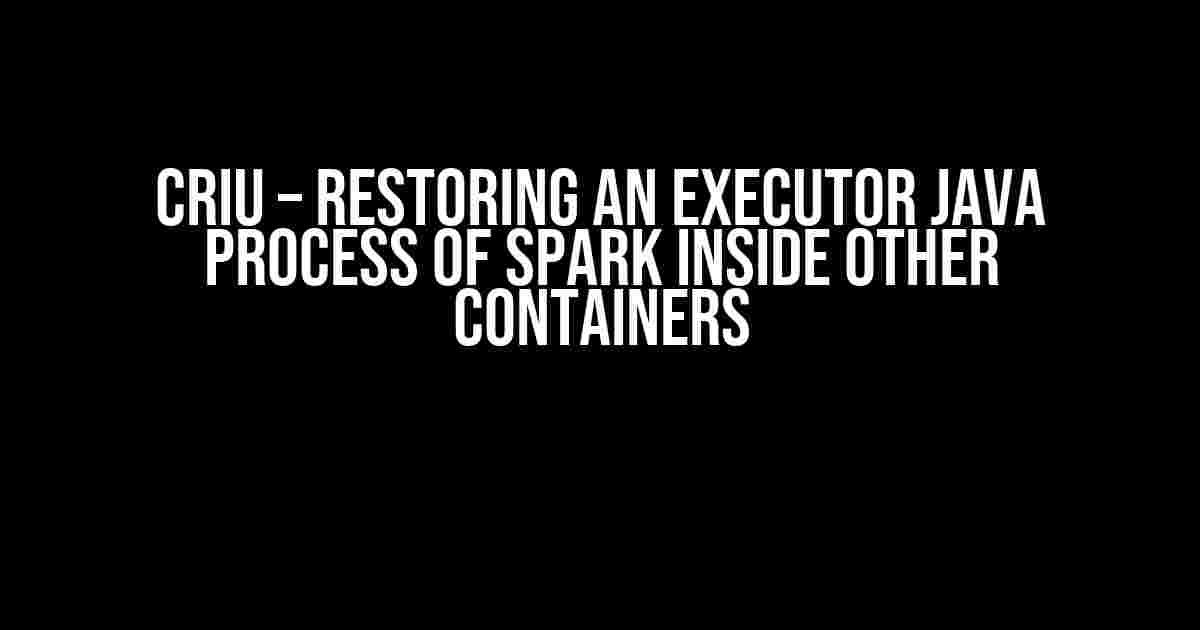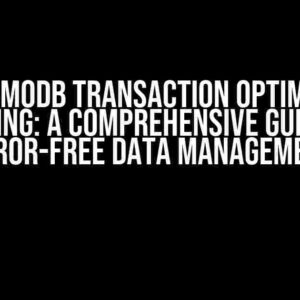Are you tired of dealing with the complexities of containerization and distributed computing? Do you want to learn how to seamlessly restore an executor Java process of Spark inside other containers? Look no further! In this comprehensive guide, we’ll take you on a thrilling journey through the world of CRIU, Spark, and containerization. Buckle up, and let’s dive in!
What is CRIU?
CRIU (Checkpoint/Restore In Userspace) is an amazing open-source project that allows you to freeze and restore Linux processes. Yep, you heard that right! With CRIU, you can capture the entire state of a process, including its memory, open files, and network connections, and then restore it later. It’s like pausing a video game and resuming it from exactly where you left off.
Why Do We Need CRIU?
In today’s fast-paced world of distributed computing, applications often consist of multiple containers and processes that need to communicate with each other. However, when an executor Java process of Spark crashes or becomes unresponsive, it can be a real pain to recover from. That’s where CRIU comes in – it allows you to checkpoint the process and restore it later, minimizing downtime and data loss.
Setting Up the Environment
Before we dive into the juicy stuff, let’s set up our environment. We’ll need:
- Docker installed on your system
- Spark 3.x installed on your system (we’ll use Spark 3.1.2 in this example)
- CRIU installed on your system (we’ll use CRIU 3.15 in this example)
Make sure you have the necessary packages installed, and you’re ready to go!
Creating a Spark Application
Let’s create a simple Spark application that we’ll use to demonstrate the magic of CRIU. Create a new Java file called `SparkApp.java` with the following code:
import org.apache.spark.SparkConf;
import org.apache.spark.SparkContext;
import org.apache.spark.api.java.JavaRDD;
import org.apache.spark.api.java.JavaSparkContext;
public class SparkApp {
public static void main(String[] args) {
SparkConf conf = new SparkConf().setAppName("Spark App");
JavaSparkContext jsc = new JavaSparkContext(conf);
JavaRDD<String> rdd = jsc.parallelize(Arrays.asList("Hello", "World"));
rdd.foreach(s -> System.out.println(s));
jsc.stop();
}
}Compile the code and package it into a JAR file called `spark-app.jar`.
Running Spark Inside a Container
Now, let’s create a Docker container that runs our Spark application. Create a new file called `Dockerfile` with the following contents:
FROM openjdk:8
WORKDIR /app
COPY spark-app.jar /app/
CMD ["java", "-jar", "spark-app.jar"]Build the Docker image by running the following command:
docker build -t spark-app-image .Run the Docker container using the following command:
docker run -d --name spark-app-container spark-app-imageCheckpointing the Executor PROCESS USING CRIU
Now that our Spark application is running inside a container, let’s checkpoint the executor process using CRIU. First, we need to install CRIU inside the container:
docker exec -it spark-app-container /bin/bash
apt-get update
apt-get install criuNext, we need to find the PID of the executor process:
jps -l | grep ExecutorTake note of the PID, and then use the following command to checkpoint the process:
criu dump -v4 -o /tmp/checkpoint --leave-running --pid <executor_pid>Replace `
Restoring the Executor PROCESS USING CRIU
Now, let’s simulate a failure by stopping the container:
docker stop spark-app-containerTo restore the executor process, we’ll create a new container and use CRIU to restore the checkpoint:
docker run -d --name spark-app-container-restore spark-app-image
docker exec -it spark-app-container-restore /bin/bash
criu restore -v4 -i /tmp/checkpoint --pid 1This command will restore the executor process from the checkpoint, and it will continue running where it left off.
Troubleshooting Common Issues
When working with CRIU and containerization, you might encounter some common issues. Here are some troubleshooting tips:
| Error | Solution |
|---|---|
| Cannot find the executor process | Make sure you’re using the correct PID, and the process is still running. |
| Checkpoint file is corrupted | Try re-creating the checkpoint file or check the CRIU version. |
| Restore process fails | Check the CRIU logs for errors, and make sure the container has enough resources. |
Conclusion
In this article, we’ve explored the magical world of CRIU and containerization. We’ve learned how to set up our environment, create a Spark application, run it inside a container, checkpoint the executor process using CRIU, and restore it later. With these skills, you’ll be able to tackle even the most complex distributed computing challenges.
Remember, practice makes perfect. Try experimenting with different scenarios, and don’t be afraid to push the limits of what’s possible. Happy coding, and see you in the next adventure!
Frequently Asked Question
Get answers to the most asked questions about restoring an executor Java process of Spark inside other containers using CRIU!
What is CRIU and how does it help in restoring Java processes?
CRIU (Checkpoint/Restore In Userspace) is a Linux-based open-source software that allows you to freeze and restore processes, including Java processes. In the context of Spark, CRIU helps in restoring the executor Java process inside other containers, allowing for faster and more efficient recovery in case of failures or crashes. This means you can resume your Spark job from where it left off, minimizing data loss and downtime.
What are the benefits of using CRIU with Spark?
Using CRIU with Spark provides several benefits, including faster recovery times, reduced data loss, and improved overall system availability. By checkpointing and restoring Spark executor processes, you can minimize the impact of failures and reduce the need for expensive recomputation. Additionally, CRIU enables more efficient use of resources, as you can resume from the last checkpoint rather than restarting from scratch.
How does CRIU integrate with Spark to restore executor processes?
CRIU integrates with Spark through a custom plugin that allows you to checkpoint and restore executor processes. When a failure occurs, CRIU creates a checkpoint of the executor process, including its memory state and open files. The plugin then restores the process from the checkpoint, allowing the executor to resume where it left off. This integration enables seamless recovery of Spark jobs, minimizing downtime and data loss.
What types of containers can I use with CRIU and Spark?
You can use CRIU with various types of containers, including Docker, Kubernetes, and Mesos. CRIU supports a wide range of container runtimes, allowing you to deploy and manage Spark workloads within your existing containerization infrastructure. This flexibility enables you to leverage the benefits of CRIU and Spark in a variety of deployment scenarios.
Are there any limitations or caveats to using CRIU with Spark?
While CRIU provides a powerful solution for restoring Spark executor processes, there are some limitations and caveats to be aware of. For example, CRIU may not work correctly with certain types of file systems or network storage. Additionally, restoring a process from a checkpoint may not always result in an identical state, and some Spark features, such as Spark UI, may not be preserved. It’s essential to carefully evaluate the suitability of CRIU for your specific use case and environment.



